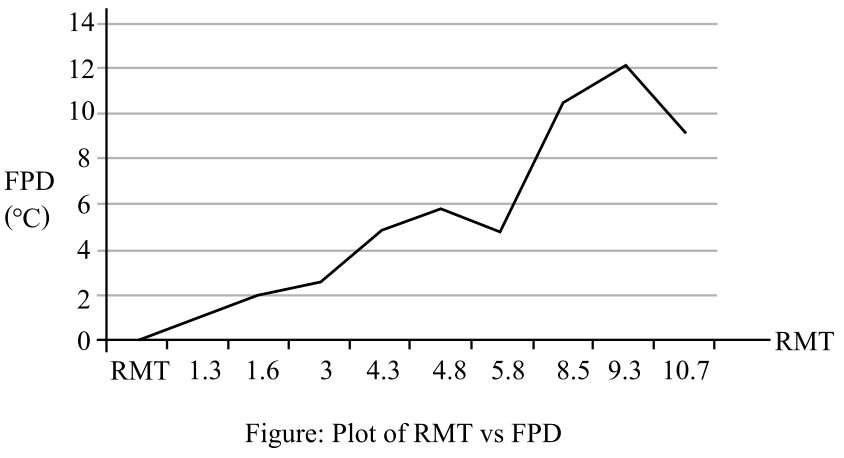
To review:
The relative medullary thickness (RMT) is a good predictor to determine an animal’s ability to produce concentrated urine or not, based on an RMT vs freezing point depression (FPD) plot.
Given:
The RMT and the FPD for different mammals are given in the Table 1:
Table 1: The RMT and FPD of different mammals.
| Animal | RMT | FPD (ᵒC) |
| Beaver | 1.3 | 0.96 |
| Pig | 1.6 | 2 |
| Human | 3 | 2.6 |
| Dog | 4.3 | 4.85 |
| Cat | 4.8 | 5.8 |
| Lab rat | 5.8 | 4.85 |
| Kangaroo rat | 8.5 | 10.4 |
| Jerboa | 9.3 | 12 |
| Sand rat | 10.7 | 9.2 |
Introduction:
RMT refers to the thickness of medulla of the kidney divided by volume (length X width X thickness) of the entire kidney. FPD is a test, which is used to measure the concentration of urine. It is known that fresh water freezes at 0°C, but the addition of solutes lowers this freezing temperature.
Explanation of Solution
The graph plot between RMT and FPD is given in the Figure 1.

Figure 1: Plot of RMT vs FPD.
It can be observed from the graph that as the RMT increases, the FPD also increases. This means that the concentration of the urine increases with an increase in relative length of loops of Henle. The graph follows an almost linearly increasing trend.
A slight deviation from the trend is observed in case of the laboratory rat and the sand rat.
Therefore, it can be concluded that the RMT is a good predictor of the ability of the mammal to produce concentrated urine.
Want to see more full solutions like this?
Chapter 51 Solutions
EBK LIFE: THE SCIENCE OF BIOLOGY
- 22. Which of the following mutant proteins is expected to have a dominant negative effect when over- expressed in normal cells? a. mutant PI3-kinase that lacks the SH2 domain but retains the kinase function b. mutant Grb2 protein that cannot bind to RTK c. mutant RTK that lacks the extracellular domain d. mutant PDK that has the PH domain but lost the kinase function e. all of the abovearrow_forwardWhat is the label ?arrow_forwardCan you described the image? Can you explain the question as well their answer and how to get to an answer to an problem like this?arrow_forward
- Describe the principle of homeostasis.arrow_forwardExplain how the hormones of the glands listed below travel around the body to target organs and tissues : Pituitary gland Hypothalamus Thyroid Parathyroid Adrenal Pineal Pancreas(islets of langerhans) Gonads (testes and ovaries) Placentaarrow_forwardWhat are the functions of the hormones produced in the glands listed below: Pituitary gland Hypothalamus Thyroid Parathyroid Adrenal Pineal Pancreas(islets of langerhans) Gonads (testes and ovaries) Placentaarrow_forward
- Describe the hormones produced in the glands listed below: Pituitary gland Hypothalamus Thyroid Parathyroid Adrenal Pineal Pancreas(islets of langerhans) Gonads (testes and ovaries) Placentaarrow_forwardPlease help me calculate drug dosage from the following information: Patient weight: 35 pounds, so 15.9 kilograms (got this by dividing 35 pounds by 2.2 kilograms) Drug dose: 0.05mg/kg Drug concentration: 2mg/mLarrow_forwardA 25-year-old woman presents to the emergency department with a 2-day history of fever, chills, severe headache, and confusion. She recently returned from a trip to sub-Saharan Africa, where she did not take malaria prophylaxis. On examination, she is febrile (39.8°C/103.6°F) and hypotensive. Laboratory studies reveal hemoglobin of 8.0 g/dL, platelet count of 50,000/μL, and evidence of hemoglobinuria. A peripheral blood smear shows ring forms and banana-shaped gametocytes. Which of the following Plasmodium species is most likely responsible for her severe symptoms? A. Plasmodium vivax B. Plasmodium ovale C. Plasmodium malariae D. Plasmodium falciparumarrow_forward
 Human Physiology: From Cells to Systems (MindTap ...BiologyISBN:9781285866932Author:Lauralee SherwoodPublisher:Cengage LearningCase Studies In Health Information ManagementBiologyISBN:9781337676908Author:SCHNERINGPublisher:Cengage
Human Physiology: From Cells to Systems (MindTap ...BiologyISBN:9781285866932Author:Lauralee SherwoodPublisher:Cengage LearningCase Studies In Health Information ManagementBiologyISBN:9781337676908Author:SCHNERINGPublisher:Cengage Human Heredity: Principles and Issues (MindTap Co...BiologyISBN:9781305251052Author:Michael CummingsPublisher:Cengage Learning
Human Heredity: Principles and Issues (MindTap Co...BiologyISBN:9781305251052Author:Michael CummingsPublisher:Cengage Learning





